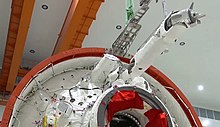Mengtian module
 Diagram of the Mengtian module | |
| Module statistics | |
|---|---|
| COSPAR ID | 2022-143A |
| Part of | Tiangong space station |
| Launch date | 31 October 2022, ~07:30 UTC (planned)[1][2] |
| Launch vehicle | Long March 5B (Y4) |
| Mass | ~20,000 kg (44,000 lb) |
| Length | 17.9 m (59 ft) |
| Diameter | 4.2 m (14 ft) |
Mengtian (simplified Chinese: 梦天; traditional Chinese: 夢天; pinyin: Mèng Tiān; lit. 'Dreaming of the Heavens[3]'), officially the Mengtian laboratory cabin module (Chinese: 梦天实验舱), is a major module of the Tiangong space station. It will be the second Laboratory Cabin Module launched, and the second module to extend the existing Tianhe core module of the station.
Purpose
The Mengtian laboratory module will provide a pressurized environment for researchers to conduct science experiments in freefall or zero gravity which could not be conducted on Earth for more than a few minutes. Experiments can also be placed on the outside of the modules, for exposure to the space environment, cosmic rays, vacuum, and solar winds. It will have its own airlock.
The axial port of Mengtian will be fitted with rendezvous equipment and will first dock to the axial port of Tianhe. A mechanical arm dubbed, as Indexing robotic arm, looking a sort of Lyappa arm used on the Mir space station then moves Mengtian module to a portside port of the TCM.[4][5][6] It is different from Lyappa as it works on a different mechanism. Lyappa arm is needed to control the pitch of the spacecraft and redocking in a different plane. But the indexing robot arm is used when docking is needed in the same plane. In addition to this arm used for docking relocation, the Chinarm on Tianhe module can also be used as a backup in place of Indexing robot arm.[7][8]

In addition to this, it will also carry a small 5 m (16 ft) long robotic arm like the Chinarm as a supplemental to that arm. It will be used for manipulating extravehicular payloads and its positioning accuracy is 5 times better than the Chinarm. Mengtian has standard adaptors (silver squares) to host the payloads.[9] There is also an adapter by which this arm can be grappled by the Chinarm it to work a single robotic arm like Orbiter Servicing Arm on Canadarms.[10]
Electrical power is provided by two steerable solar power arrays, which use photovoltaic cells to convert sunlight into electricity. Energy is stored to power the station when it passes into the Earth's shadow. Resupply ships will replenish fuel for LCM 2 for station-keeping, to counter the effects of atmospheric drag.
Launch
Mengtian is scheduled to launch on 31 October 2022.[1][2] It will be inserted into a low Earth orbit with an average altitude of 393 km (244 mi) at an orbital inclination of 42 degrees.[11][12]
See also
Assembly
The Shenzhou 14 mission to the space station will assist with setting up the Mengtian module in orbit.[13]
References
- ^ a b Jones, Andrew (31 May 2022). "Rocket to launch China's next space station module arrives at launch center". SpaceNews. Retrieved 1 June 2022.
- ^ a b "SCIO briefing about China's progress on space station construction | english.scio.gov.cn". english.scio.gov.cn. Retrieved 2022-04-18.
- ^ "Planned space station details made public". China Daily. 2018-04-26.
The two space labs, Wentian, or Quest for Heavens, and Mengtian, or Dreaming of Heavens
- ^ Graham, William; Gebhardt, Chris (April 28, 2021). "China readies launch of Tianhe module, start of ambitious two-year station construction effort". NASASpaceflight.com.
This means the two future science modules, Wentian ("Quest for the heavens") and Mengtian ("Dreaming of the heavens"), cannot dock directly to their planned radial port locations. [...] To account for this, each module will carry a Russian Lyappa robotic arm — like the ones used on Mir for the same purpose — to move the module from the forward port to its respective permanent location on a radial port of Tianhe's docking hub.
- ^ Hong Yang (2020). Manned Spacecraft Technologies. Singapore: Springer. ISBN 978-9811548970.
- ^ Graham, William; Gebhardt, Chris (April 28, 2021). "China readies launch of Tianhe module, start of ambitious two-year station construction effort". NASASpaceflight.com.
- ^ Hong Yang (2020). Manned Spacecraft Technologies. China: Springer. p. 355. ISBN 978-9811548970.
- ^ Graham, William; Gebhardt, Chris (April 28, 2021). "China readies launch of Tianhe module, start of ambitious two-year station construction effort". NASASpaceflight.com.
- ^ Twitter https://twitter.com/cnspaceflight/status/1550846854123778049. Retrieved 2022-07-23.
{{cite web}}: Missing or empty|title=(help) - ^ Twitter https://twitter.com/cnspaceflight/status/1543492387950931969. Retrieved 2022-07-23.
{{cite web}}: Missing or empty|title=(help) - ^ Barbosa, Rui C. (1 March 2021). "China preparing to build Tiangong station in 2021, complete by 2022". NASASpaceFlight. Retrieved 15 March 2021.
- ^ David, Leonard (7 March 2011). "China Details Ambitious Space Station Goals". Space.com. Retrieved 23 February 2012.
- ^ "Completion of the Heavenly Palace: Tiangong in 2022 - Dongfang Hour". 4 February 2022.
